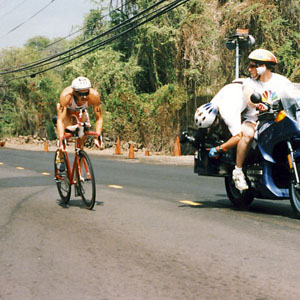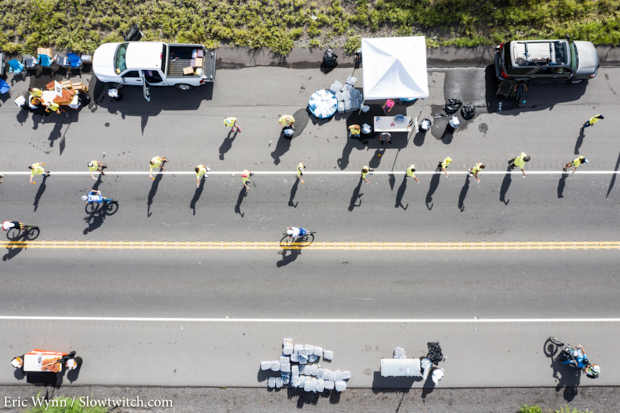Ken Glah – 30 straight at Kona
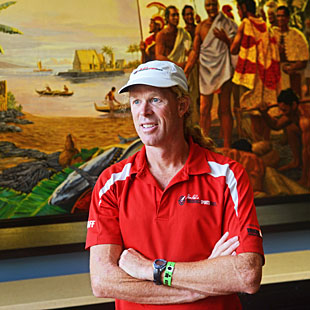
Back in 1984, 20-year-old Ken Glah arrived at Kailua-Kona and struggled through his very first Ironman Hawaii with a very lopsided set of splits. New to swimming, he managed a creditable 57:54, which he followed with a strong-for-the-era 5:22:25 bike split which put him into T2 in 9th place. He held on through Mile 12 of the run before his lack of proper nutrition and simple exhaustion faded him to a 5:49:25 marathon – slower than his 112-mile bike – and a 12:09:44 finish.
Such a tough day would send most athletes running from such a painful experience far faster than they soldiered through the final miles. Thankfully for the sport, Ken Glah's appetite for more of this epic Kona race was only whetted.
On Saturday, October 12 Ken Glah crossed the finish line at the Ironman World Championship in 10 hours, 43 minutes and 35 seconds. He finished 70th of 169 in the men's 50-54 category, 1,054th of 1,964 overall finishers – a modest day at the office for a man who just set an amazing landmark at one of the world's toughest endurance challenges.
The finish was Ken Glah's 30th straight official finish at the Ironman World Championship, a mark that makes him a prime candidate to be the Ironman's Iron Man. In the early days, Ken Glah made the top 10 on the greatest Ironman 10 times. He finished 3rd once, 4th two times, 5th two times, 6th once, 7th twice, and 9th and 10th once apiece. His fastest time was 8:24:01 when he placed 5th overall in 1993, and now he lopes through the race in just over 10 hours at age 50 – with very little training.
Fourteen years ago, Lynn Brooks and Scott Tinley earned well deserved applause for finishing 20 straight times at Ironman Hawaii. Such feats seemed like one of those sports records like pitcher Cy Young's 500-plus wins or Cal Ripken Jr,'s 2,400-plus games played streak. But quietly, persistently, Ken Glah kept plugging away and just obliterated Tinley and Brook's milestones, creating a new monument to endurance and consistency.
Glah, who now helps triathletes get to far-flung races in style with his Endurance Sports Travel Company, looks smooth and graceful in his red warm-up suit a few days before his yearly appointment on the Queen K. His hair is shorter than the long mane he sported for much of his career, but his skin is smooth, his eyes clear, his gait the unhurried walk of a former champion. He spoke of his long streak to Slowtwitch in the lobby of the King Kamehameha Resort Hotel.
Slowtwitch: What sports did you play in high school and university?
Ken Glah: I grew up as a runner. Did a little bit of riding just for fitness. Didn't race at all but did some long trips — camping trips and stuff like a 100-mile-a-day 7 or 8 days in a row.
ST: Best times and distance as a runner?
Ken: I got down to about 9:12 for the two mile in my freshman year in college at LaSalle. I went to LaSalle for a year then started doing triathlons pretty much full time. Think it was 9:20 something in high school.
ST: What did you think of Ironman Hawaii – the myth and reality when you first heard of it?
Ken: I saw it on TV and it caught my eye when I was still in high school.
ST: Few other kids in high school were thinking about it like you were?
Ken: I don't think so. But running was something I was hoping to do at that point. Then I got into university and realized that how crazy the whole system was. There were 28 and 29 year old freshmen from England and Ireland and Africa and so forth coming over and grabbing the US scholarships. It was I felt like a little kid racing against adults when I was in my first year racing in University.

ST: So the new sport of triathlon looked like a way to use your talents?
Ken: I wasn't sure that I had the speed required to do what I wanted to do in running. And I really enjoyed training. I did one triathlon before entering University and really enjoyed it. And after I left LaSalle and had to sit out for a year before I was eligible to compete again, I did triathlons that whole year and decided not to go back to competing in track at University. So yeah. I really enjoyed going out and training for 6 or 8 hours. Whereas you can only run so much in a week before you got injured. So, it was a perfect solution.
ST: To make a living, you got some early sponsorships. You were one of the Philadelphia area athletes along with Jeff Devlin to race for one of the prominent early triathlon sponsors, Team Foxcatcher.
Ken: I had already been racing professionally a year and a half or so before Foxcatcher started to happen. My first sponsorship was some local sports stores. And Dave McGillivray of Saucony sponsored me real early on. Dave of course has gone on to do some great stuff as race director of the Boston Marathon.
ST: What was your first triathlon like?
Ken: It was in Rhode Island and it was a long race — a mile and half swim, 60 mile bike and a 15 mile run. Going into the race I had three weeks to learn how to swim and I was swimming two or three times a day because of how exhausted I was getting. I could only swim for so long before I was completely wiped out. Mile and half swim with no wetsuit.
ST: You did pretty well at your first Ironman at age 20?
Ken: It was in 1984. I was pretty ready except for nutritionally I didn't do a very good job, that's for sure. I was in pretty good shape but it took me over 12 hours. Just before coming to Kona for the first time, I finished 4th at the Nice International Triathlon. So I had some pretty high expectations.
ST: You were worn out after Nice?
Ken: No, it was a climate shift. I was living at Penn State and going to school in State College. After getting back from Nice, it was September and I was working out in tights and long sleeves. So when I came out here, on race day I just got fried. I was 57 minutes [57:54] out of the water in about 70th place and worked my way up to 7th place on the bike. [5:22:25 split] When I got off the bike, I was in 8th and held 9th place until Mile 12. After 12, it unraveled quickly. So my bike time was 30 minutes faster than my run time. [run 5:49:25, total time 12:09:44 in ].
ST: Did that race whet your appetite or discourage you?
Ken: It definitely whet my appetite. To be a 20 year old sitting in 9th or 10th place at Mile 12 of the Ironman was good. There were some very good people around me.. So I came back the next year. I had bronchitis unfortunately and wound up about 16th or 17th. Then '86 was my first good race. I finished up 6th that year. [9:09:30 – 41 minutes behind Dave Scott]
ST: You felt like you belonged then?
Ken: I had quite a nice string after that.

ST: Did you have the long hair always from the beginning?
Ken: Somewhere in the late '80s I started growing my hair.
ST: Your inspiration for that?
Ken: No inspiration. I just always liked long hair.
ST: When did you have your first serious contention for the win at Kona?
Ken: In '88 I came off the bike right up there with Molina [-3:30] and Mike Pigg. [-2:36] I think I got off the bike in 3rd. Coming down Alii Drive I was within about 30 seconds of Mike Pigg and Scott Molina was 2 or 3 minutes in front of us. My mistake that day was not catching Mike because given how ferocious a competitor he was, I think the two of us running side by side would have helped both of us to close the gap. Molina had a great race that day and neither of us got him. [Molina ram 3:02:42, Pigg 3:04:06, and Glah ran 3:06:47] So we pretty much stayed that way the whole run. Mike pulled more than 30 seconds ahead of me at the end. But position-wise we stayed 1st, 2nd and 3rd the whole run.
ST: How did that make you feel?
Ken: Obviously that whet my appetite even more. I was encouraged by the fact that there were some tactical things I did wrong, not necessarily physical things.
ST: It gave you something to work on
Ken: Yeah. That was my best finish position at Kona, not necessarily my best race.
ST: You had another 3rd at Kona?
Ken: I never had another 3rd. I had a couple 4ths (1989, 1993) a couple 5ths (1987, 1995). But 3rd in '88 was my best position finish.
ST: How much joy did you take from racing Kona in the early days?
Ken: Oh a lot. When you are competing at a high level of course you want to go to the premier race and compete against everybody. Nobody was looking past Kona. Everybody was shaved, tapered and knew that was the race. That's what you want — to show up and race against the best on a tough course.
ST: I was writing about your race at Kona in 1994 for the Philadelphia Inquirer and you were in the lead for a long way into the run.
Ken: In 1994 I led until mile 8 of the run. I had some shin splits earlier and decided to stick with my training shoes which made my legs feel good until they got wet and heavy. But yeah I hadn't been running as much as I'd hoped to going into the race. So, I came off the bike well [4:37:42, 3rd best after Jurgen Zack and Jeff Devlin and ahead of Greg Welch and Dave Scott] and ran well early on. But I wasn't able to hold it together and finished 9th [after a 3:12:13 run].
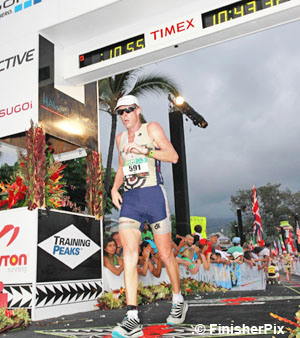
ST: Irrespective to your place, what was your best race at Kona?
Ken: Ah, '95 was probably my best race. I felt very consistent the whole day in all three legs and finished on 5th place. [51:54 swim-4:46:47 bike-2:51:59 run and 8:30:40 total – 10 minutes behind winner Mark Allen] There were quite a few people together in contention late in the bike ride. It was tight all the way through. Greg Welch was right ahead of me in 4th [1:26 ahead]. And a few people were not far behind me. That was the year that Mark Allen caught Thomas Hellriegel at Mile 23.
ST: When did you stop being in contention for the overall?
Ken: In the late '90s, I still had some very good races. I won Ironman Brazil several times. I still felt like I could be up there in the late '90s ('97 Ironman Hawaii 7th, 2000 Ironman Hawaii 10th). Once I started my business I know that was the end. I formed Endurance Sports Travel in 2002, the first year I took people on a trip to a race for my company.
ST: You have one of the best triathlon travel companies in the world. You guide age groupers and their families to see the world and the races. What led you to do that?
Ken: My involvement with Ironman Brazil. I wanted to make it easier for foreign athletes to get down to Brazil from Europe, the U.S. and other parts of South America and feel comfortable with the trip.
ST: You raced really well in the mid-'90s.
Ken: Yes. That's when I won the long race in Brazil in the first four years they had it. The first one wasn't a full Ironman distance. The next three years it was a full Ironman. I got together with a few people – the race director from Santos, Carlos Galvan and some other people joined to formed Latin Sports. We went to the WTC and got the contract for travel to the race in 2001.
ST: How did your travel business become a success?
Ken: I think a big part of it was that we try to make it work well for the family as well as the athlete. And the destination races we picked to start off with also played a big part. Now they are so many great places to go. In the beginning it was Brazil, then Pucon, Chile and Ironman Switzerland. This year I think we handle about 25 races.
ST: How big has the business become?
Ken: Brazil is our biggest race. We have 1200 people who come to that race through us. The last two years we had 500 athletes and 700 family members. from all over the world. A lot of those are Brazilians who travel with us. Most of our other races are between about 70 and 200 people. Brazil is by far the biggest and Florida will be our second biggest.
ST: What is your business model?
Ken: We do well as a company not based off any one individual race. We do well off volume. The whole idea was to keep the price low per person and still be able to offer good services because of numbers. The best race we have is Ironman Brazil because we have so many people. So we are able to hire a lot of people and offer a lot of services to keep the price down because we have the volume. As each race grows we are able to offer the same things. The more people you get you can offer more services and keep the price the same or lower your prices.
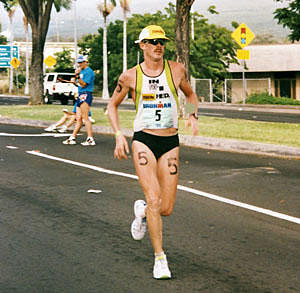
ST: So have you had days where you were in danger of quitting?
Ken: Here luckily I never had any races where I had to walk a long way. I had races where I walked-jogged late in the race when things were really tough. The one year I really felt like I wanted to give up, it just so happened that was the morning Reanin said to me 'Never give up.' That happened in the '90s. Reanin was pretty young. The wheels were really falling off — and I stuck with it. About 3 miles after that low point out on the highway. things came back together. I had lost a few places but I moved myself back up. again. I guess the closest year to not finishing was my first year when it took me almost six hours to do the run [5:49:25].
ST: Tinley struggled hard to make it 20 straight and so did Lynn Brooks. Were you ever close to a DNF?
Ken: On race day there never was a close call. As far as trying to hold it together and race well, I can't remember what year but I remember waking up early in one morning and my daughter Reanin said: "Daddy never give up."
ST: Reanin came across the finish with you many times. How old is she now?
Ken: She is 20.
ST: Does she like sports?
Ken: Yeah she was a gymnast for years, then played a little bit of volleyball. Now she is living in Australia. She is studying to be a wedding planner and is running a lot of trips with me.
ST: Similar businesses?
Ken: It is all about event management. That is really what wedding planning is, and that is what triathlon travel is — customer service.
ST: Does she like triathlons?
Ken: She did a couple of sprint triathlons. But it never got to be a big part of her life.
ST: Ever worried about finishing?
Ken: No, but there's so many things that can go wrong out there. Especially on a windy day — there are so many chances of getting blown off the bike. You having a problem or somebody else having a problem and you are bumping into each other. Yeah as hot and horrible as it is out there, it doesn't take much of a mistake to throw you over the edge.
ST: Bad things have happened to everybody else in the Ironman world – Paula Newby-Fraser, Mark Allen and many tremendous triathletes at the top of their game have had crazy things go wrong.
Ken: Things can go really wrong. Obviously I am not competing at a high level any more so and I run fewer risks as I am not pushing the red line like I once did.
ST: What was the first year you were not competing at a high level in Hawaii?
Ken: I'd say probably 2003 or 2004 would have been the first years where my training just was really cut back because of my business workload.
ST: Ever stood back and looked at what a streak of 30 finishes in Hawaii means?
Ken: No I don’t look at it. I don’t want to put too much emphasis on it and somehow jinx myself. And it's not just on race day. The chances of something happening in the days leading up to it are just as great. I have somebody on my trip here from Argentina — three days before she got on the plane, she broke her foot. She was just out for a run — nothing unusual — and broke her foot.
ST: What are your times these days?
Ken: Last year I was a bit over 10 hours. [10:12:27] If I get a few weeks of training on this course I can finish somewhere between 10 hours and 10:15. I just need a few decent weeks of training. I can kind of be there as long as nutrition goes well.
ST: Ever speak to Lynn Brooks or Scott Tinley, who were famous as the first two to finish 20 straight times at Ironman Hawaii?
Ken: No, I never spoke about the streak with Scott. I obviously speak to him but I don't see him that often. But I see him once every year or two. I'd rather talk about other stuff than talk about triathlons. Just what's going on in his life. I haven't seen Lynn for years. She was race director for the Baltimore USTS race for years and put on a bunch of other races.
ST: Underneath your calm demeanor, what does this streak mean to you?
Ken: It means a lot.. I think as far as athleticism I don't think it is that big a deal.
ST: Some say you need good muscular-skeletal body alignment to do what you've done this long.
Ken: To a certain extent yeah. But I have really flat fleet. So biomechanically it doesn't mean that everything was ideal. But I adjusted for that by getting orthotics and getting worked on by physiotherapists and massage professionals. I had shin splints for many years – it was normally a problem of running too many miles too quickly after having a break. Every winter I had a break. So as I built back up into things slowly, my lower legs would adjust to the tension caused by having flat feet. Once I got orthotics that helped alleviate that problem quite a bit.
ST: If you take away all the externals, is there some pure thrill derived from running along Alii Drive, the Natural Energy Lab and the Queen K? Is there some kind of inner joy about the simple act of running?
Ken: Oh yeah definitely. I think it happens more so on training runs and rides than it does in a race. But yeah there is nothing more I love more than being out there. On race day, because of how hard you are pushing, unless things are really going well, it is not always the most enjoyable feeling. Of course, when you cross the finish line, it makes up for all the difficult times out on the course.
ST: Your biggest danger during the streak might have been trying to keep me alive on the climb up snow-capped Mount Villarica in Pucon in 2003. I thank you because that allowed me the distinct pleasure of reaching the top and taking several slides down the snow on the way down.
KEN LAUGHS
ST: What will your message to anybody your friends when you cross the line?
Ken: My mom [who is 86] will be there at the finish and hopefully Reanin will be there. I have only been able to do this with the support I have received from my family — from [his wife] Jan, [daughter] Reanin, my mom and dad and my and brothers and sisters. All 5 of my sisters will be out there to watch the race this year.
ST: How big is your family?
Ken: There are seven boys and six girls in my family. Thirteen kids. I was number 12 of 13.
ST: Thank you for your time.


